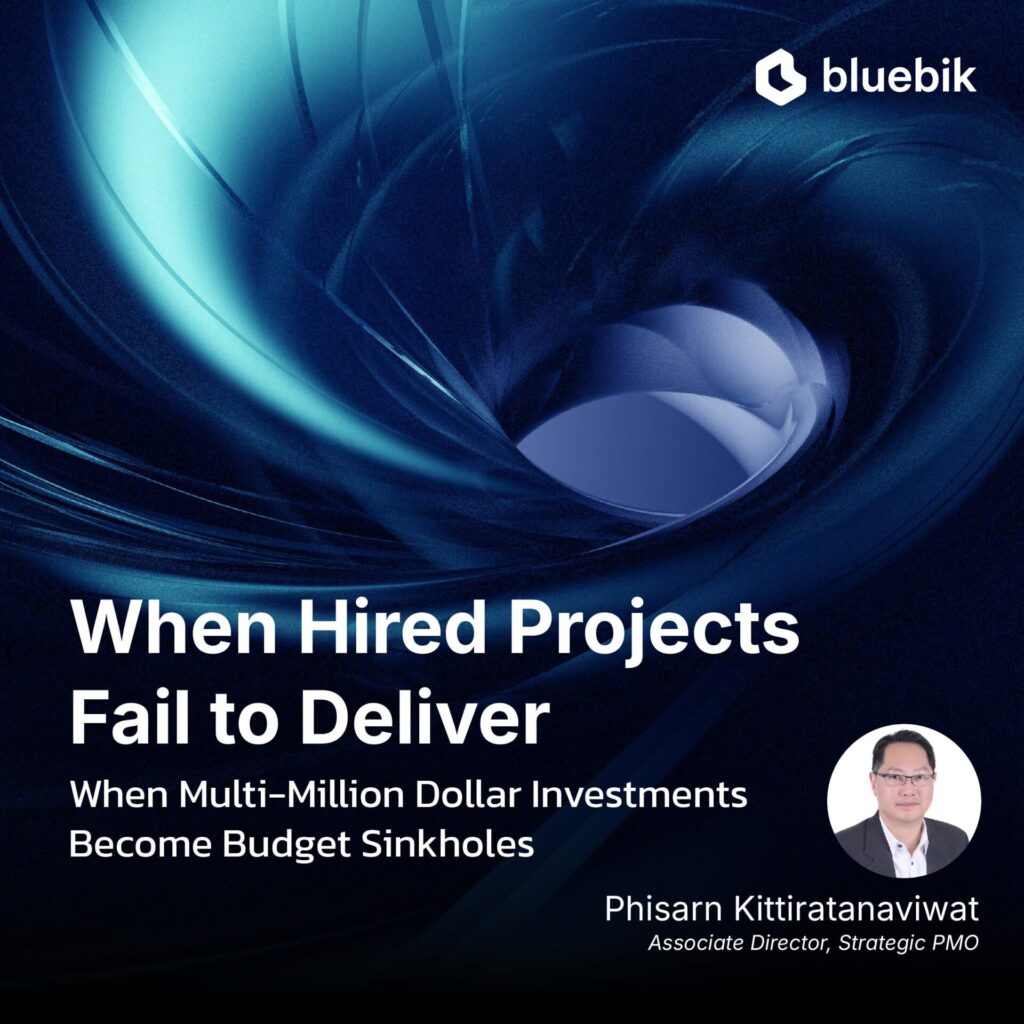When Multi-Million Dollar Investments Become Budget Sinkholes
As organizations accelerate their Digital Transformation initiatives to leverage technology for enhanced business growth, they face increasingly complex challenges. Successfully managing large-scale technology projects to deliver tangible business outcomes requires rigorous planning and execution.

Consider a Super App development project for a major financial institution requiring full feature integration within a single platform. With a workforce of hundreds spanning internal teams and multiple vendor partners, the project encountered critical issues: the payment module failed to integrate with core systems, vendor-delivered UI/UX components were inconsistent with the organization’s Design System, performance degraded significantly under concurrent user loads, security testing revealed multiple critical vulnerabilities, timelines extended indefinitely, and budget overruns became unmanageable.
Similarly, a Payment Gateway system development project for a mid-sized bank—designed to process high-volume transactions and integrate with dozens of partners—faced substantial challenges. Each vendor employed different frameworks without unified coding standards, significantly complicating maintenance. Documentation was fragmented, test coverage was insufficient, bug resolution required weeks, and no stakeholder could confidently guarantee system stability at go-live.
How should organizations mitigate these development risks?
Strategic Risk Mitigation in Project Development
For large-scale system or IT infrastructure development projects, comprehensive system testing represents a critical success factor. Rigorous testing ensures new or enhanced systems operate efficiently, securely, and align with business requirements. This process identifies errors, vulnerabilities, and potential issues before production deployment.
Establishing Control: Test Methodology + Governance
Project development risk stems fundamentally from inadequate frameworks and governance structures. Testing must not be relegated to a final phase—it should constitute a strategic process integrated throughout the project lifecycle.
- Build Assurance: Validates that systems function as designed
- Mitigate Risk: Identifies and resolves issues before operational impact
- Enhance Quality: Improves system performance, stability, and security
- Ensure Compliance: Confirms adherence to business requirements and regulatory standards
- Optimize Costs: Pre-deployment remediation typically costs significantly less than post-production fixes
Developing a Comprehensive Digital System Testing Strategy
- Establish Testing Objectives: Define clear QA requirements across functionality, security, performance, interface design, and user experience for your digital services
- Determine Testing Resources: Assess whether to conduct testing internally (contingent on team expertise and resource availability) or engage specialized external testing partners
- Schedule Testing Activities: Implement strategic testing schedules (following each feature release, at development milestones, or through continuous testing protocols)
- Define Testing Scope: Strategically select device and platform coverage based on user analytics and market research, recognizing comprehensive coverage across all devices is impractical
- Select Testing Methodologies: Balance scenario-based testing for initial validation with exploratory testing for comprehensive defect identification and UX assessment
- Implement Defect Management: Establish robust systems for documenting, tracking, and resolving defects to enable efficient identification, analysis, and remediation
Six Critical Challenges in System Testing
While testing is fundamental to success, organizations commonly encounter complex obstacles:
- Technological Complexity: Managing and testing integrated environments spanning cloud infrastructure, AI, IoT, and legacy systems
- Accelerated Release Cycles: Accommodating rapid, frequent testing requirements driven by continuous deployment practices
- Legacy System Integration: Ensuring seamless interoperability between innovative digital solutions and established systems
- Resource Constraints: Addressing insufficient testing personnel or tooling to meet digital transformation demands
- Regulatory Compliance: Navigating diverse and evolving industry regulations and standards
- Data Integration Complexity: Harmonizing data from disparate sources while maintaining quality standards across the digital ecosystem
PMO: The Strategic Variable in Risk Prevention
The Project Management Office (PMO) provides essential frameworks, processes, and support structures to enable effective digital system testing. Key PMO contributions include:
1. Test Strategy & Planning
- Align Testing with Business Objectives: PMO ensures testing teams comprehensively understand Digital Transformation business goals, aligning testing strategy with organizational vision and desired outcomes
- Define Scope and Prioritization: PMO establishes testing scope and prioritization based on business risk assessment and user impact analysis
- Integrate Testing into Project Governance: PMO embeds testing activities within the master project plan, ensuring adequate allocation of time, resources, and budget across development phases
2. Resource & Budget Management
- Secure Personnel and Tooling: PMO identifies testing capability requirements and procures necessary resources, including Test Automation Tools, Performance Testing Tools, and Test Management platforms
- Exercise Budgetary Control: PMO allocates and monitors testing budgets to ensure efficient utilization within approved parameters
3. Standardization & Process Framework
- Establish Testing Standards: PMO defines organizational standards and best practices for testing protocols, including Test Case documentation, defect reporting procedures, and test approval processes to ensure consistency and quality
- Drive Technology Adoption: PMO promotes adoption of advanced testing capabilities, including AI-Powered Testing and Cloud-Based Testing, to enhance efficiency and reduce testing cycles
4. Risk Management
- Identify and Assess Risks: PMO collaborates with testing teams to identify testing-related risks—including schedule, resource, and technical constraints—and develops comprehensive mitigation strategies
- Monitor and Report Risk Status: PMO continuously tracks testing-related risks and provides executive reporting to enable informed, timely decision-making
5. Progress Monitoring & Reporting
- Track Key Performance Indicators: PMO establishes and monitors critical testing KPIs, including test pass/fail rates, Defect Discovery Rate, and Test Coverage metrics
- Deliver Executive Reporting: PMO consolidates data and delivers comprehensive status reports to leadership and stakeholders, providing visibility into quality status and production readiness
6. Communication & Coordination
- Facilitate Cross-functional Alignment: PMO serves as the coordination hub between testing, development, business, and executive teams, ensuring shared understanding of testing status and issues
- Resolve Impediments: When testing obstacles or conflicts arise, PMO facilitates resolution and minimizes impact on overall project delivery
A robust PMO with clear accountability for testing governance enables organizations to accelerate Digital Transformation with quality assurance, risk mitigation, and confidence that systems will perform as required.
Strategic Imperatives to Ensure Project Success
- Governance Before Development: Establish comprehensive frameworks and standards prior to initiating development activities
- PMO as Strategic Orchestrator: PMO must function beyond task tracking to serve as the strategic orchestrator aligning all workstreams toward unified objectives
- Continuous Testing Integration: Testing should not constitute a final gate but rather be embedded throughout the development lifecycle
- Strategic Vendor Partnerships: Engage vendors as strategic partners rather than transactional contractors
- Commitment to Continuous Improvement: Recognize that no system achieves perfection initially—establish processes for ongoing iteration and enhancement
Multi-million dollar investments demand strategic discipline, not speculative execution. Success requires robust Framework, Process, and Governance structures to eliminate hidden risks that threaten project outcomes. Organizations facing these challenges or initiating major projects benefit significantly from partners who provide both strategic perspective and implementation expertise, ensuring Digital Transformation delivers measurable business value rather than budget overruns.
For organizations seeking to develop strategic PMO capabilities to enhance competitive advantage and drive growth, Bluebik offers comprehensive digital transformation consulting services. Our Strategic PMO practice delivers end-to-end solutions and advanced analytics capabilities, from strategic planning through implementation tailored to your organizational context. For inquiries, contact [email protected] or call 02-636-7011.










![Thumbnail [Post Event] HOW](https://bluebik.com/wp-content/uploads/2025/12/Thumbnail-Post-Event-HOW.png)

